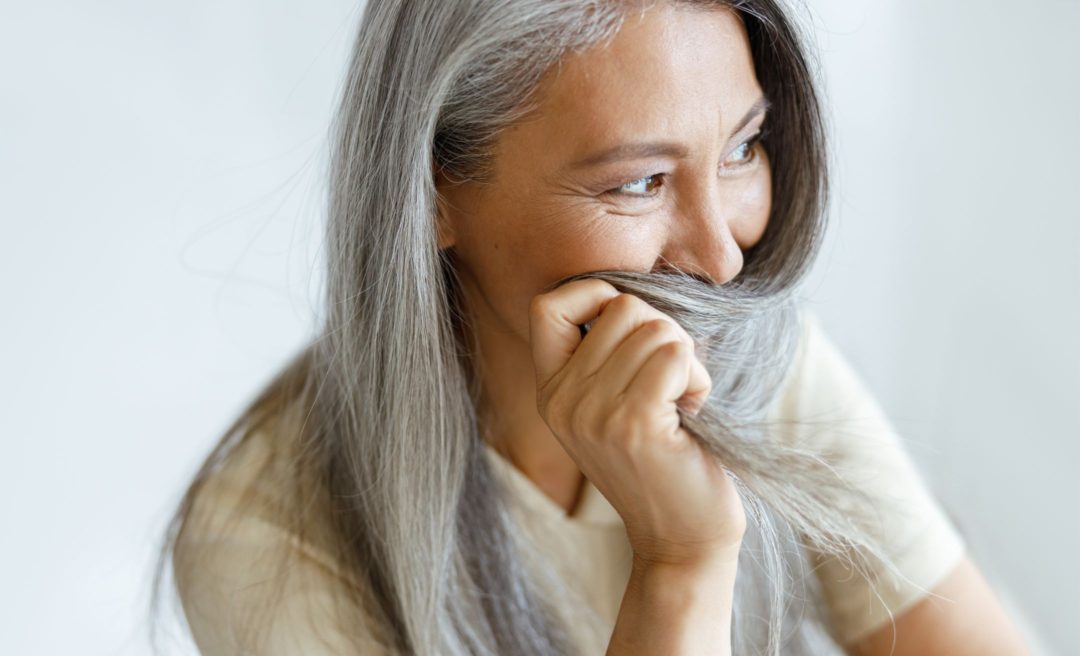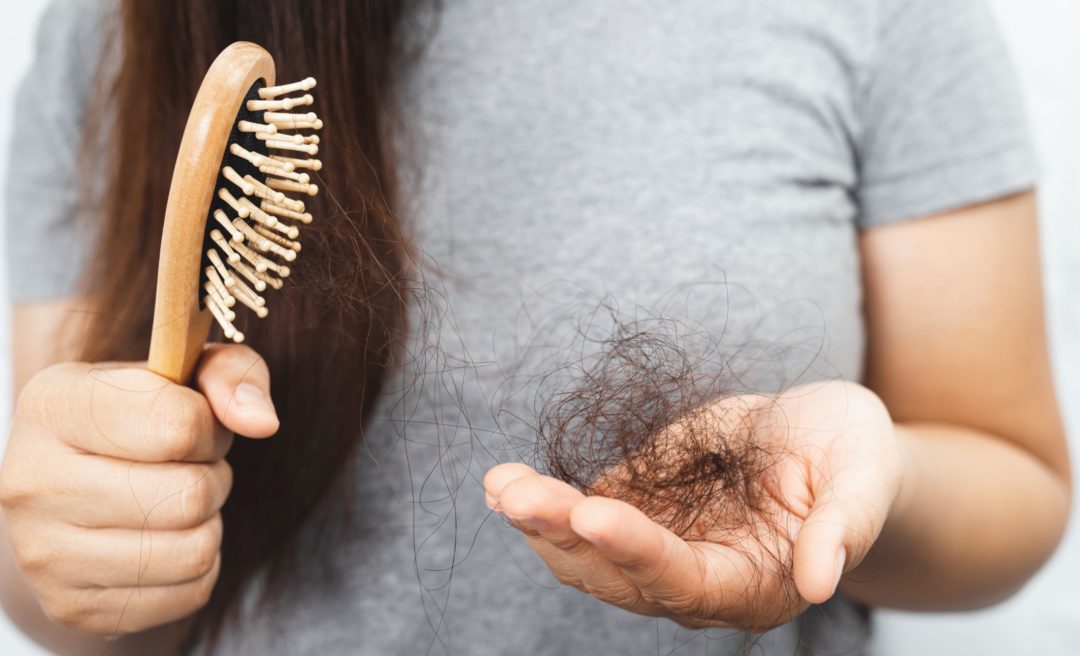
Don’t dread the shed. There are things you can do to treat and cope with hair loss.
If you’ve been noticing more hair on your brush, in the shower drain or on the bathroom floor these days, you’re not alone.
Hair loss is a common malady that affects millions of women, especially in the years surrounding menopause. The Cleveland Clinic estimates that more than 50 percent of women will experience hair loss at some point in their lives, most often during periods of hormonal change.
While there are many types of hair loss, the most prevalent among women over 40 is Androgenetic Alopecia, or Female Pattern Hair Loss. While most cases of FPHL are triggered during midlife, this condition can begin in your 30s or even earlier, and may be experienced alongside other types of hair loss.
Because the symptoms of hair loss are often subtler in women than in men (most of us will experience overall thinning rather than bald spots), you may not be bothered by thinning hair until you’re years into it. You may eventually notice your part widening, the hair near your temples getting more sparse, or your ponytail getting narrower and think, “What the hell is going on?”
Although there’s no “cure” for hair loss, depending on what type you have and how long it’s been going on, there are things you can do to prevent further loss and try to regain some of what’s already slithered down the drain. There have been many developments in hair-loss treatments through the decades, and some emerging technologies are showing promise. There are also holistic approaches and other remedies that, even if they can’t get you back the hair you had at 25, can help to restore your scalp health and put the luster back into your locks.
Why Am I Losing Hair?
There are many reasons you might lose some hair throughout your lifetime. Hair loss, which is technically known as Alopecia, is a disorder caused by an interruption in the body’s cycle of hair production.
On average, the scalp has 100,000 hairs that cycle through periods of growing, resting, falling out and regenerating. A hair growth cycle consists of three phases. During the anagen phase, which can last for years, the hair grows actively. During the catagen phase, which lasts about 10 days, the hair stops growing and separates from its follicle. During the telogen phase, the follicle rests for two or three months, and then the hair falls out. The next anagen phase begins as a new hair grows in the same follicle. Most people lose 50 to 100 hairs per day as part of this natural cycle. If this cycle is disrupted, or if a hair follicle is damaged, hair may begin to fall out more quickly than it is regenerated.
Hair loss can be linked to a person’s genetics, although many medical and behavioral conditions can interrupt the growth cycle and cause hair loss. These are some of the most common types:
Androgenetic Alopecia (Female Pattern Hair Loss)
As previously mentioned, Female Pattern Hair Loss is a common complaint among women in midlife. It affects more than 30 million women in the United States alone. The condition is genetic, and you can inherit the genes from your mother, father or both. Because FPHL is so prevalent in the years surrounding menopause, hormones may also play a role. Unlike men, women who suffer from this type of hair loss rarely go bald; they usually just experience overall thinning. Many women accept this type of hair loss as a natural part of aging, unless it becomes noticeable enough to bother them. While there’s not much you can do about the genetic component of FPHL, there are numerous medications and treatments that can help to slow down the shedding and possibly grow back some hair, as well as cosmetic procedures to make your hair appear fuller. We’ll get into all of those later.
Telogen Effluvium
This type of hair loss can happen at any point in your life. It occurs when a large number of hair follicles enter the resting (telogen) phase of the growth cycle, but the next growth phase doesn’t begin. This causes hair to fall out all over the scalp without new hair growth. Although it rarely leads to complete baldness, Telogen Effluvium may cause the shedding of 300 to 500 hairs per day. This type of hair loss can be triggered by a medical event or health condition (such as a thyroid imbalance, childbirth, surgery, extreme stress or fever), a vitamin or mineral deficiency (such as iron deficiency), certain medications, and even starting or stopping oral contraceptives. The shedding usually begins around three months after the triggering event or condition. If the trigger is temporary—for example, if you recover from an illness or stop taking the medication causing the hair loss—your hair will likely grow back after six months. Telogen Effluvium is considered chronic if hair loss lasts longer than six months. For reasons that are unclear to doctors, this type of hair loss may last for years in some people. If hair doesn’t regrow on its own, your dermatologist can prescribe medications to help.
Anagen Effluvium
Anagen Effluvium is rapid hair loss resulting from a medical treatment such as chemotherapy. These potent and fast-acting medications kill cancer cells, but they may also shut down hair follicle production in the scalp and other parts of the body. After chemotherapy ends, hair usually grows back on its own. Dermatologists can offer medication to help hair grow back more quickly.
Alopecia Areata
Alopecia Areata is an autoimmune condition in which the body’s immune system attacks the hair follicles, causing hair to fall out and preventing new hair from growing. Hair loss can begin suddenly and without warning. Hair from the scalp typically falls out in small patches and is not painful. Hair in other parts of the body, including the eyebrows and eyelashes, may also fall out. Dermatologists can treat this condition with medication.
Cicatricial Alopecia
This is a rare type of hair loss in which inflammation destroys hair follicles and causes scar tissue to form in their place. Other symptoms include severe itching, swelling and scalp lesions. This type of hair loss can occur at any age and affects both men and women. Treatment depends on the type of cicatricial alopecia causing your symptoms.
Central Centrifugal Alopecia (CCCA)
CCCA is a disease characterized by hair loss that begins in the central crown of the scalp and widens over time. Accompanying symptoms include burning, itching, tenderness, redness, scaling or flaking, and acne-like bumps on the scalp. Researchers aren’t sure what causes this type of hair loss, but it’s possibly linked to bacterial and fungal infections, genetics, autoimmune disease, and hairstyling practices. Your doctor can prescribe topical steroids and other medications.
Traction Alopecia
This type of hair loss is caused by hairstyles—such as tight ponytails and braids—that pull hair away from the scalp with such force that strands are damaged and fall out. If you switch to a gentler hairstyle, the hair usually grows back.
What Kind of Hair Loss Do I Have?
Because there are so many kinds of hair loss, it’s best to make an appointment with your dermatologist to get a proper diagnosis. Trichologists, relatively new healthcare specialists who focus on conditions related to the hair and scalp, are also able to provide guidance; however, they aren’t physicians so they can’t diagnose certain conditions or prescribe medications and should refer you to a dermatologist if your hair loss is severe.
Research suggests that hair loss in midlife women is most frequently the result of hormonal changes. The hormones estrogen and progesterone keep hair in the growing phase, making it grow faster and stay on the head longer. When your levels of estrogen and progesterone drop, hair starts to regrow more slowly and become thinner. A decrease in these hormones also triggers an increase in the production of androgens, a group of male hormones that can shrink hair follicles on the head (and, in some cases, cause the growth of “peach fuzz,” or facial hair).
However, other factors may also contribute to hair loss during midlife. High stress levels, illness and medical conditions, and a lack of certain nutrients may also play a role. Your doctor can offer diagnostic blood tests to help rule out other causes of hair loss that may not be FPHL. You can find a physician near you through the American Board of Dermatology.
Home Remedies For Hair Loss
The symptoms of hair loss can sometimes be alleviated with lifestyle changes. Doctor-prescribed medications, treatments and procedures will be addressed in the next section, but here are some methods you can try at home first.
Reduce Stress
If you’re experiencing hair loss, the first thing you should do is try to reduce stress in your life (I know, easier said than done). If you’re having trouble managing your stress, try some of these calming techniques. If the hair shedding itself is what’s making you anxious, you’re not alone. Hair loss is an emotional issue, as we grew up believing that our hair was tied to our attractiveness and femininity. Which we know now is completely BS. (I mean, how many gorgeous women have we seen lately with buzz cuts or shaved heads?) I’ve been experiencing hair shedding for the last decade, and at one point when it was particularly bad, I had to remind myself that at the end of the day, it’s only hair, not a life-threatening illness. And that even if the shedding became unmanageable, I could shave it all off and have fun with wigs. Perspective, right?
Hair loss is an emotional issue, as we grew up believing that our hair was tied to our attractiveness and femininity. Which we know now is completely BS.
Be Kind to Your Hair
Limit the use of straighteners, hair dryers and other hair-damaging tools. Go easy on the hair color for a while. Try a scalp-stimulating shampoo that promotes circulation and makes hair appear fuller. Use a clarifying shampoo to remove product build-up and blockage.
Nourish Yourself
Healthy eating should be your first line of defense against hair loss. Eat a balanced, low-fat diet that includes whole grains, fruits and vegetables. Incorporate healthy oils such as olive oil, as well as essential fatty acids like salmon, tuna, flaxseed, walnuts and almonds, into your diet. Drink green tea.
Look Into Your Meds
Some medications have side effects that include hair loss. If you’re experiencing significant shedding and think your medication might be the reason, talk to your doctor. (Don’t stop taking your medications until you’ve consulted with your physician).
Hydrate, Hydrate, Hydrate
Your body needs to be hydrated in order to function properly. Load up on H2O all day long and pass on the sugar-laden juices and flavored drinks. The amount of water needed varies from person to person and depends on various factors, including overall health and exercise intensity. As a general rule, aim to sip eight 8-ounce glasses of water per day.

What Else Can I Do?
If your hair loss continues even after you’ve made lifestyle changes, you may want to look into supplements, medicines, treatments and procedures that can increase your line of defense against future hair loss—and possibly help to regain some of the locks you lost. Some of these are over-the-counter, while others must be prescribed or performed by a doctor. The good news is that a lot of research is being done on this very common problem, so there always seems to be something new to try.
Supplements & Diet
While the findings are mixed, some studies have shown that certain supplements may grow and thicken hair. These include biotin, iron, vitamin D, vitamin C, zinc, folic acid, fatty acids and antioxidants. Make sure yo are getting enough of these in your diet, or else talk to your doctor about supplementation. There are both over-the-counter and prescription supplements that can support the growth of new, healthy hair. Some of them can interact with medications, so again, it’s important to consult with your doctor before embarking on a new vitamin regimen.
Make sure your diet is well balanced, and that you consume a rainbow of fruits and vegetables daily. It’s also important to get enough lean protein (which is also helps with maintaining and building muscle).
There is evidence that sulforaphane, a natural plant compound found in many cruciferous vegetables like broccoli, cabbage, cauliflower and kale, promotes hair growth by decreasing the expression of Dihydrotestosterone (DHT), which has been linked to androgenetic alopecia. Raw vegetables have the highest levels of sulforaphane, with one study finding that raw broccoli had 10 times more than cooked. Broccoli sprouts may contain 10 to 100 times as much sulforaphane than mature broccoli; learn how to grow your own here.
Minoxidil
Commonly known by the brand name Rogaine, Minoxidil is the only drug approved by the Food and Drug Administration for FPHL. This medication is a vasodilator that widens the blood vessels to increase blood flow to the scalp and hair follicles. It’s available over the counter or in prescription strength and comes in spray, liquid or foam. Minoxidil must be used continuously for months before you see results. Common side effects are an irritated scalp and increased hair growth on the face. Women who are pregnant or nursing should avoid Minoxidil.
Antiandrogens
Antiandrogen drugs like Spironolactone, Finasteride, Flutamide and Dutasteride are sometimes prescribed for hair loss. These drugs are usually given in conjunction with a topical treatment like Minoxidil, and can help to restore hair growth and prevent hair loss from worsening. Before taking any of these meds, tell your dermatologist about your medical conditions, including kidney and adrenal gland problems, as well as other medications and supplements you’re taking. Antiandrogen drugs can have side effects, which your doctor should explain, and should not be taken if you’re pregnant or nursing.
Platelet-Rich Plasma Therapy
This treatment uses your own blood to stimulate your scalp to grow hair. Your doctor will draw some blood from your arm and put it into a machine that separates it into its different components. The platelets, which are a type of blood cell, are injected into your scalp. Researchers are just beginning to study this therapy as a treatment for FPHL, but the early results are promising. (Ongoing research is also being done on stem-cell treatments for hair loss, so stay tuned.)
At-Home Lasers
FDA-approved laser combs, wireless caps and other devices, which are available without a prescription, can treat hair loss at home. These devices emit a low level of laser light that may help stimulate new hair growth. A few studies show that this can be effective for treating FPHL. As with Minoxidil and prescription medicines, you must continue using this device to see results. We still do not know whether these devices are safe for long-term use or if they can continue to produce new hair growth.
Hair Transplants
Long used to treat hair loss in men, a hair transplant may be an option for some women with FPHL. If the hair on your scalp is sparse all over, you may not have enough healthy hair to transplant, but a hair transplant surgeon can tell you if you’re a candidate for this—which has improved significantly through the decades.
Hormone Replacement Therapy
Because hormones often play a part in midlife hair loss, hormone treatments can be beneficial. Perimenopausal and menopausal women who are undergoing hormone replacement therapy may notice an improvement in hair growth during treatment. However, HRT should only be used if you’re suffering from multiple symptoms, not just hair loss. For more on HRT and how it works in the body, listen to the More Beautiful Podcast’s episode HRT 101.
Camouflage
If you hate the idea of taking medications, or you’re looking for a quick fix to mask thinning hair while looking at treatment options, there are several things you can try:
- Get a shorter haircut with volume-adding layers and bangs.
- Use one of the popular over-the-counter sprays that are designed to cover up gray roots, but also work great for covering a wide part. L’Oreal Paris Magic Root Coverup, Bumble and Bumble Hair Powder or Toppik Hair Thickening Spray are good choices.
- If you’re in a pinch, a cute baseball cap, sunhat or beanie makes a fun fashion statement.
- Scalp Micropigmentation (SMP) is a relatively new cosmetic procedure that’s done in your dermatologist’s office. Similar to what microblading can do for your eyebrows, this procedure uses an electric tattoo device to create the illusion of fuller hair, especially if you want to cover up a widening part or a receding hairline.
- Wigs are more natural looking and gorgeous than ever before, and if you’re a style maven they can add a little zest to your fashion ensembles. Pink bob one day, blonde curls the next. I mean, talk about variety and easy styling.
- Shave it off. Tired of dealing with the shedding altogether? I’ve seen some buzz cuts and bald heads on the hippest, hottest ladies out there and think this look is on-trend and badass. Plus, it’s easier to apply scalp treatments to a bare scalp, right?
The Bottom Line
There are many reasons for hair loss. But there are ways to slow it down and even regrow some of your beloved locks. Start with the home remedies (particularly the one that involves de-stressing!), but please talk to your doctor if you’re losing hair rapidly or in an unusual pattern, have an irritated scalp or other symptoms, or are experiencing shedding before any other signs of perimenopause.
Most hormone-related shedding, like all the other crazy symptoms associated with midlife, slows with time and can be controlled with the techniques we discussed. But because this type of hair loss isn’t harmful to your health, it’s also perfectly OK to just accept it. After all, there are more important things in life to stress over, right? The great thing is that the decision is totally up to you.
So take a deep breath…exhale…and remember, your hair doesn’t define you. Even if some of it has left the building, it didn’t take with it any of your beauty, power, wisdom or experience.
Sources:
Interventions for Female-Pattern Hair Loss
Medical Treatments For Male and Female Pattern Hair Loss
Hair Loss in Women: Medical and Cosmetic Approaches to Increase Scalp Hair Fullness
Female Pattern Hair Loss—An Update
The Five Best Vitamins For Hair-Loss Prevention
Low-Level Laser Treatment Can Stimulate Hair Follicles and Hair Growth




